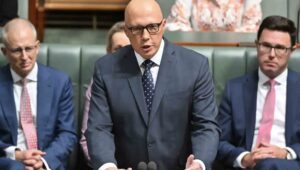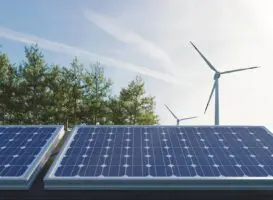Plans to build a 900MW wind farm on Robbins Island in north-west Tasmania have got the green light from the state’s Environmental Protection Authority, but only under the extraordinary condition that all 122 of the project’s turbines are shut down for five months of each year.
In an update late last week, the Tasmania EPA said its board had determined that the massive wind farm can go ahead, but with “significant mitigation measures” to protect the critically endangered orange-bellied parrot.
EPA chair Andrew Paul said the project’s threat to the orange-bellied parrot (OBP), a bird that is the subject of a National Recovery Plan, had led to the inclusion of condition FF6, which imposes shutdown periods totalling five months when the turbines cannot operate.
“Condition FF6 states that ‘Unless otherwise approved in writing by the EPA Board, all Wind Turbine Generators must be shut down during the northern OBP migration period (1 March to 31 May inclusive) and the southern OBP migration period (15 September to 15 November inclusive)’,” the report says.
Beyond these conditions, however, the EPA concludes that the broader benefits of the proposed wind farm “outweigh the low level of mitigated risk” to the parrot.
“These benefits include making a significant contribution to the economy of Tasmania, as well as making a major contribution to the renewable energy available to both Tasmania and mainland Australia, thereby reducing dependence on fossil fuels,” the EPA report says.
“It is considered that this project forms a key plank of Tasmania’s 200% renewable energy target by 2040 and to the Commonwealth government goal of reducing greenhouse gas emissions by 43% below 2005 level by 2030 and net zero emissions by 2050.”
Huge wind plans for a small island
The Robbins Island wind farm is being proposed by ACEN Australia (formerly UPC\AC Renewables) alongside the nearby Jim’s Plain Renewable Energy Park, which will include up to 31 wind turbines and solar PV with a total capacity of up to 240MW, about 23km west of Smithton.
That project has been approved by the council, state and Commonwealth government.
The Robbins Island Renewable Energy Park proposes install up to 122 wind turbines over the western two-thirds of the island and potentially battery storage.
The project includes construction of up to three substations on Robbins Island, underground electrical infrastructure, and a range of infrastructure including construction of a bridge between Robbins Island and the mainland and of a wharf for delivery of project components.
Transmission of electricity from the project site is proposed via a new transmission line from Robbins Island Road to Sheffield – a separate project that will be subject to its own environmental impact assessments.
ACEN Australia has been contacted by RenewEconomy for comment on the EPA approval, and the impact of the turbine shutdown conditions on the wind farm’s prospects going forward.
It still needs planning approval from the Circular Head Council and federal environmental approval under the Environment Protection and Biodiversity Conservation Act.
A problematic outcome
In a statement emailed to RenewEconomy on Monday, ACEN Australia said that it had not had time to consider the implications of the permit condition.
“However, given the work undertaken over the past five-years in terms of the assessing the risks and developing mitigations, we are surprised by this condition as it does not seem commensurate with the potential risk posed to OBPs,” a spokesperson said.
“We understand that the approval and/or conditions can be appealed.”
ACEN said that in developing Robbins Island it had undertaken an extensive assessment resulting in 30+ pages of conditions to mitigation the key environmental risks.
ACEN’s Robbins Island Renewable Energy Park, inherited via its takeover of UPC\AC Renewables, has stirred some high profile local opposition based on a range of concerns, including location, size, and impact on wildlife and environment.
According to the EPA’s report, 383 representations were received in relation to the permit application, covering a range of issues including potential impacts to threatened birds and animals, threatened native vegetation and flora species and noise emissions.
Some of the more vocal critics of Robbins Island have included local groups like the Circular Head Coastal Awareness Network and BirdLife Tasmania, as well as the founder and former leader of the Australian Greens, Bob Brown, who in 2019 said the project’s benefits were outweighed by its impacts on scenery and bird life.
In a statement from the Tasmanian Greens last week, the party’s state environment spokesperson, Dr Rosalie Woodruff, said Robbins Island is “simply the wrong place” for a wind farm.
“While the EPA has put in place a five-month shutdown condition to protect the orange-bellied parrot, the other conditions in their approval will not be enough to stop significant impacts on the many other species that inhabit this internationally-significant island ecosystem,” Woodruff said.
“Robbins Island is also an incredibly significant area for the Tasmanian Aboriginal community, with dozens of cultural heritage sites already identified in preliminary field surveys.”
An example set by Cattle Hill
Should Robbins Island go ahead under the EPA’s set conditions, it would not be the first wind farm in Tasmania to have turbines that are shut down to protect local bird populations.
The 144MW Cattle Hill wind farm in Tasmania’s Central Highlands conducted an Australia-first trial of an aerial monitoring and detection system, called IndentiFlight, designed to mitigate its impact on the endangered Tasmanian wedge-tailed eagle.
The project, owned by Power China Group and Goldwind Capital Australia, uses tower-mounted optical units – 16 of them are spread out across the wind farm – to detect flying objects, and then algorithms to identify them as eagles.
If an eagle’s speed and flight trajectory puts it on a collision path with a turbine, the system then sends a signal to shut that turbine down.
For Goldwind, the Cattle Hill planning permit conditions allowed for five eagle mortalities in its first year of operation. But the team behind the project wanted to aim for zero harm.
As Goldwind’s project director Leigh Walters told RenewEconomy last year, that goal has more or less been achieved – but it has been an enormous and costly undertaking, with the team still assessing how eagle activity and turbine shutdowns are affecting the overall productivity of the wind farm.
“On average, we’re seeing about 400 curtailment signals sent to a turbine daily within the wind farm, with each shutdown averaging slightly more than two minutes, or about 14.5 hours daily on average across the 48 turbines,” Walters told RE.
Many pieces to Tasmania’s renewable energy puzzle
ACEN, or AC Energy Corp, is the listed energy platform of the Philippines-based Ayala Group, which in March increased its ownership in UPC\AC Renewables to 80%, on track for 100% by early 2023. The acquisition led to the rebranding of UPC\AC Renewables to ACEN Australia.
In Tasmania, ACEN is also proposing to build an up to 1.26GW wind farm in the state’s north-east – a proposal that in August was declared a Major Project by the state Liberal government, making it part of a streamlined development assessment process overseen by an independent panel.
The North East Wind project would be built across two sites – Waterhouse in the west and Rushy Lagoon in the east. The traditional owners of the lands are the Leenerrerter, Pinterrairer, Pyemmairrenerpairrener and Trawlwoolway people.
The 210 turbine project proposes to help meet Tasmania’s goal of 200% renewables by 2040, and to cement its position as the “battery of the nation,” piping renewables to Australia’s mainland via the proposed Marinus Link undersea cable.
For the Robbins Island Renewable Energy Park, ACEN plans to first build a 340MW wind farm, with a second stage of the project bringing total capacity up to 1,000MW, subject to the development of Marinus Link.
Marinus Link and a transmission upgrade in Tasmania’s north were in October among the first recipients of the Albanese government’s $20 billion Rewiring the Nation program.
The funding for the Tassie projects was welcomed by many – including the Clean Energy Council which hailed it as a game-changer for Australia’s clean energy transition.
But the Bob Brown Foundation slammed the federal backing to fast-track major wind and infrastructure projects in Tasmania as an “ecological and economic disaster.”
The Foundation’s secretary, and former leader of the Australian Greens, Christine Milne told RenewEconomy that the projects threaten to industrialise the top half of Tasmania, from the far north west to the far north east, with steep social and environmental costs.
“Everybody seems to have forgotten the reason we are making the transition to renewable energy is to address climate – and you don’t address climate by destroying biodiversity,” she said.










